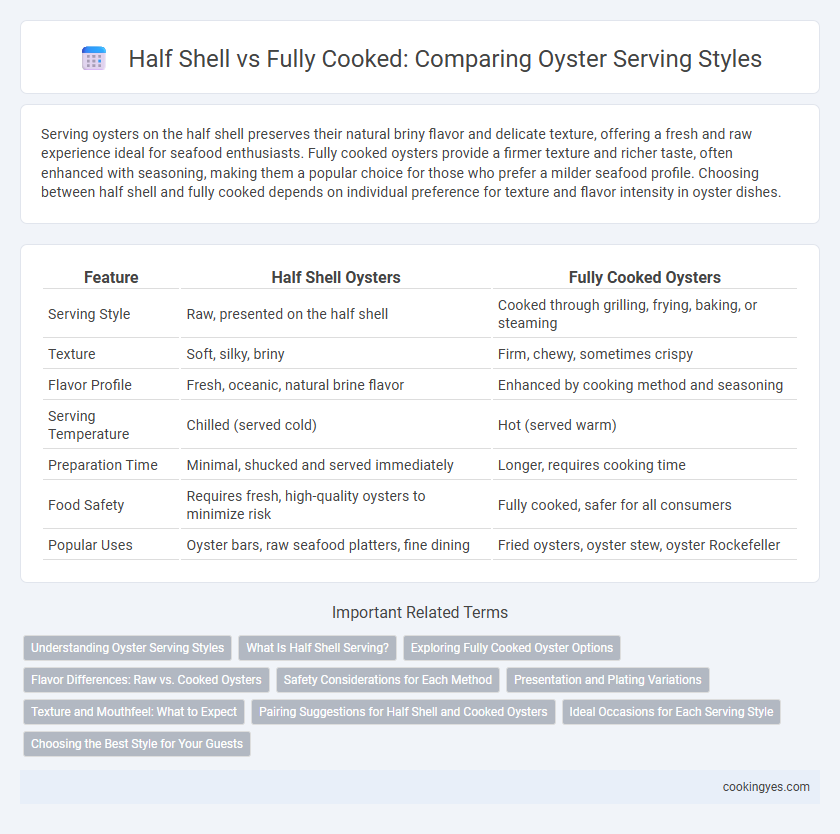Serving oysters on the half shell preserves their natural briny flavor and delicate texture, offering a fresh and raw experience ideal for seafood enthusiasts. Fully cooked oysters provide a firmer texture and richer taste, often enhanced with seasoning, making them a popular choice for those who prefer a milder seafood profile. Choosing between half shell and fully cooked depends on individual preference for texture and flavor intensity in oyster dishes.
Table of Comparison
| Feature | Half Shell Oysters | Fully Cooked Oysters |
|---|---|---|
| Serving Style | Raw, presented on the half shell | Cooked through grilling, frying, baking, or steaming |
| Texture | Soft, silky, briny | Firm, chewy, sometimes crispy |
| Flavor Profile | Fresh, oceanic, natural brine flavor | Enhanced by cooking method and seasoning |
| Serving Temperature | Chilled (served cold) | Hot (served warm) |
| Preparation Time | Minimal, shucked and served immediately | Longer, requires cooking time |
| Food Safety | Requires fresh, high-quality oysters to minimize risk | Fully cooked, safer for all consumers |
| Popular Uses | Oyster bars, raw seafood platters, fine dining | Fried oysters, oyster stew, oyster Rockefeller |
Understanding Oyster Serving Styles
Half shell oysters present a fresh, raw flavor and delicate texture, emphasizing the natural brininess and sweetness of the oyster. Fully cooked oysters, often prepared by grilling, frying, or baking, offer a richer, heartier taste with a firmer texture suitable for diverse culinary applications. Understanding these serving styles enables chefs and oyster enthusiasts to select the ideal preparation for flavor profiles and dining experiences.
What Is Half Shell Serving?
Half shell serving involves presenting fresh oysters shucked and served naturally on one shell, maintaining their briny flavor and delicate texture. This method emphasizes raw consumption, often accompanied by lemon wedges, cocktail sauce, or mignonette to enhance the oyster's intrinsic taste. Half shell oysters are prized for their freshness and are a popular choice in seafood restaurants and oyster bars for their aesthetic appeal and authentic ocean flavor.
Exploring Fully Cooked Oyster Options
Fully cooked oyster options offer a safer alternative to raw half shell oysters, reducing the risk of foodborne illness while preserving rich, briny flavors. Popular fully cooked preparations include grilled, baked, fried, and smoked oysters, each enhancing the oyster's natural taste with varied textures and seasonings. Chefs often incorporate ingredients like garlic, butter, cheese, and herbs to create savory dishes such as Oysters Rockefeller or fried oyster po'boys, appealing to consumers seeking flavorful, heat-treated seafood.
Flavor Differences: Raw vs. Cooked Oysters
Half shell oysters deliver a fresh, briny flavor with a creamy texture that highlights the ocean's natural taste, while fully cooked oysters introduce a richer, more concentrated flavor profile with a firmer, meatier bite. Cooking methods such as steaming, frying, or grilling release deeper umami notes and smoky undertones absent in raw servings. The choice between half shell and fully cooked oysters ultimately depends on the preferred balance of fresh sea essence versus bold, developed flavors.
Safety Considerations for Each Method
Serving oysters Half Shell preserves their natural texture and flavor but requires stringent sourcing from reputable suppliers to minimize the risk of harmful pathogens like Vibrio vulnificus. Fully cooked oysters eliminate many safety concerns by reaching temperatures that destroy bacteria and viruses but may compromise the delicate taste and texture oyster enthusiasts seek. Proper handling, refrigeration, and adherence to food safety guidelines are critical for both methods to prevent foodborne illnesses.
Presentation and Plating Variations
Half shell oysters showcase a natural, elegant presentation, resting on a bed of crushed ice or seaweed, enhancing their fresh, briny appeal and allowing diners to appreciate the oyster's texture and flavor directly from the shell. Fully cooked oysters offer diverse plating options, such as gratin styles with melted cheese or stuffed varieties, presenting a warm, hearty dish that emphasizes richness and complex flavors. The half shell style emphasizes simplicity and freshness, while fully cooked preparations enable creative garnishes and sauces, expanding the visual and taste experience.
Texture and Mouthfeel: What to Expect
Half shell oysters offer a briny, fresh texture with a silky, tender mouthfeel that highlights the natural juices and subtle oceanic flavors. Fully cooked oysters develop a firmer, meatier texture with a more pronounced chewiness and a robust, savory taste profile due to the heat's effect on proteins. Expect half shell servings to emphasize delicacy and freshness, while fully cooked oysters deliver a heartier, more substantial eating experience.
Pairing Suggestions for Half Shell and Cooked Oysters
Half shell oysters pair exceptionally well with crisp, mineral-driven white wines like Muscadet or Champagne, enhancing their fresh, briny flavors. Fully cooked oysters, such as those grilled or baked, complement richer beverages like buttery Chardonnay or malty pale ales that balance their smoky, savory profile. For cocktail pairings, citrusy margaritas enhance half shell oysters, while robust Bloody Marys pair seamlessly with cooked oyster dishes.
Ideal Occasions for Each Serving Style
Half shell oysters are ideal for elegant events such as cocktail parties and upscale dinners, where fresh, chilled oysters showcase their natural briny flavor and delicate texture. Fully cooked oysters suit casual gatherings like barbecues and family meals, offering a warm, rich option that pairs well with bold sauces and grilling flavors. Serving oysters appropriately enhances guest experience based on occasion, ensuring the freshest presentation or comforting cooked dish.
Choosing the Best Style for Your Guests
Half shell oysters offer a fresh, briny experience perfect for guests who enjoy natural oyster flavors served chilled with minimal accompaniments, ideal for elegant events or raw bars. Fully cooked oysters provide a versatile option that appeals to a broader audience by incorporating flavors through grilling, baking, or frying, ensuring safety and ease of consumption. Selecting the best serving style depends on balancing freshness preference, dietary considerations, and the overall culinary theme of your event.
Half Shell vs Fully Cooked for oyster serving styles Infographic

 cookingyes.com
cookingyes.com